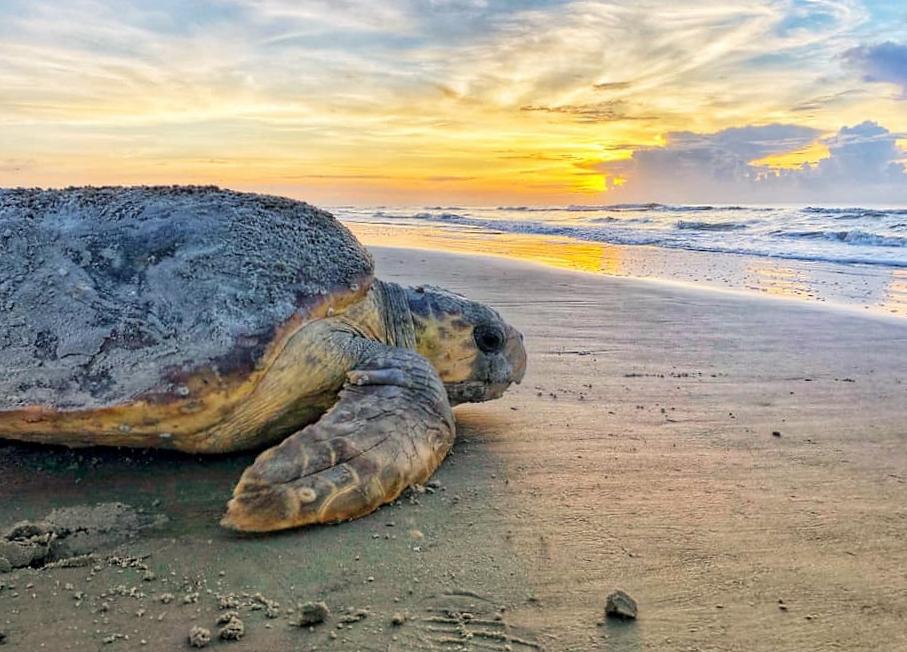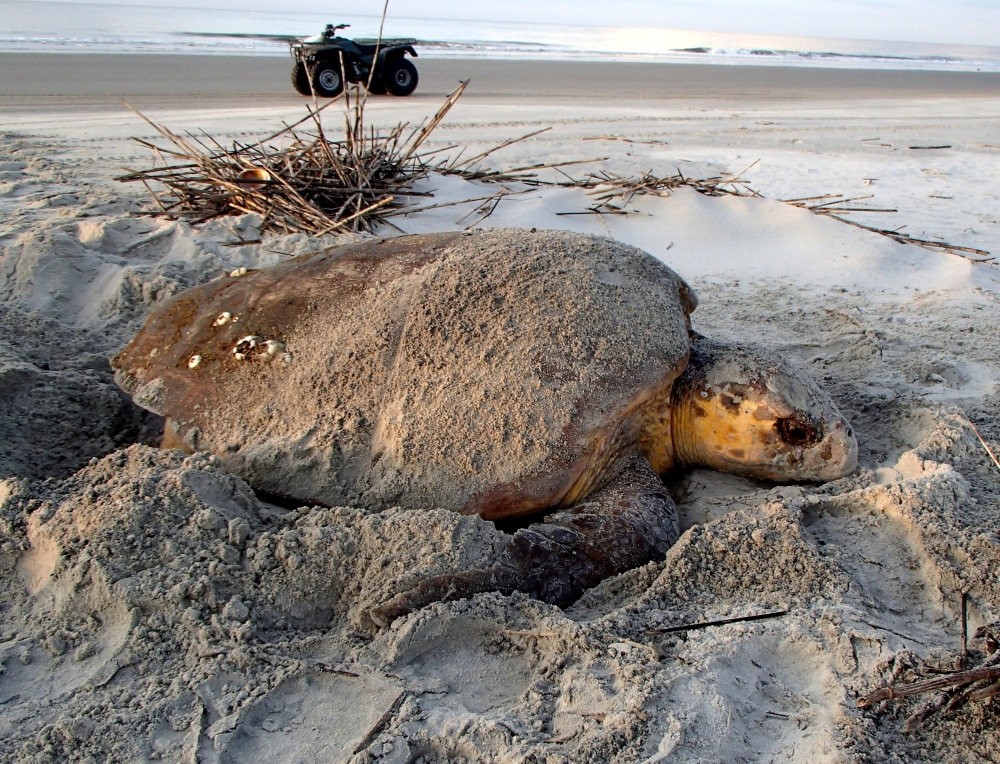
Guardians of the Sands: Loggerhead Sea Turtles’ Ancient Ritual on Turtle Island
TURTLE ISLAND – As the sun dips below the horizon, painting the sky in hues of fiery orange and deep violet, an ancient ritual begins on the pristine shores of Turtle Island. This remote, crescent-shaped barrier island, a sanctuary of wild beauty off the southeastern coast, becomes the stage for one of nature’s most enduring and perilous dramas: the nesting of the Loggerhead sea turtle ( Caretta caretta ). For millennia, these magnificent mariners have navigated vast oceanic expanses to return to the very sands of their birth, driven by an instinct far older than human civilization.
The Loggerhead, named for its massive head and powerful jaws, is a keystone species in marine ecosystems, playing a vital role in maintaining the health of coral reefs and seagrass beds by preying on bottom-dwelling invertebrates. Yet, despite their formidable appearance and crucial ecological role, they are classified as endangered globally, facing a myriad of threats that imperil their future. Turtle Island, with its undisturbed beaches and relatively low light pollution, represents a critical stronghold for their survival.
The nesting season typically spans from late spring through late summer, a period marked by anticipation among the island’s small cadre of dedicated researchers and volunteers. Each night, under the cloak of darkness, the colossal females emerge from the surf, their powerful front flippers pulling their heavy bodies across the sand, leaving distinctive, tractor-like tracks. This arduous journey, sometimes covering hundreds of feet, is an exhausting preamble to the even more demanding task ahead.
"It’s a sight that never ceases to humble me," says Dr. Anya Sharma, a lead marine biologist with the Coastal Conservation Alliance, her voice hushed with reverence. "To witness a creature that has traversed thousands of miles, navigating by the Earth’s magnetic field, return with such unwavering resolve to this specific patch of sand – it’s a testament to life’s incredible tenacity. They are living fossils, carrying the weight of evolutionary history on their backs."
Once a suitable spot is found, often above the high tide line and clear of vegetation, the female begins to dig. First, a large body pit is excavated using all four flippers, creating a shallow depression where she can settle. Then, with remarkable precision, her rear flippers meticulously scoop out a flask-shaped egg chamber, a cavity roughly two feet deep and eight inches wide, perfectly designed to cradle her precious cargo. This process can take hours, a trance-like state where the turtle seems oblivious to her surroundings, wholly consumed by the primal urge to propagate her species.

Inside this carefully constructed chamber, she deposits her clutch – typically 100 to 120 soft-shelled, ping-pong ball-sized eggs. Each egg contains the genetic blueprint of millions of years of survival, a fragile promise of future generations. Once the last egg is laid, a new phase of meticulous labor begins: covering the nest. The female uses her rear flippers to push sand back into the chamber, then employs all four flippers to broadcast sand over a wide area, meticulously camouflaging the nest from predators. This "nest dance" is designed to obscure the exact location, a vital defensive strategy. Finally, exhausted but fulfilled, she turns and slowly, deliberately, makes her way back to the ocean, disappearing into the waves until her next nesting attempt, which may occur several times within a single season.
The fate of the eggs, however, remains precariously balanced. For approximately 60 days, the clutch incubates beneath the sand, a period fraught with peril. Ghost crabs, raccoons, and even wild pigs are opportunistic predators, often digging up nests despite the mother’s best camouflage efforts. On Turtle Island, researchers and volunteers play a crucial role, often identifying nests, marking them, and sometimes covering them with protective cages to deter predators. In rare cases, if a nest is laid in a dangerously low-lying area prone to inundation, it might be carefully relocated to higher ground – a delicate operation requiring immense care to avoid disturbing the developing embryos.
"Every nest is a victory, every hatchling a glimmer of hope," explains Marcus Thorne, a long-time volunteer coordinator on Turtle Island. "Our job isn’t to interfere unnecessarily, but to give nature a fighting chance against the increasing pressures these turtles face. We are merely stewards, trying to ensure that this ancient cycle can continue."
The most dramatic phase of the cycle unfolds when the hatchlings emerge. Triggered by a decrease in sand temperature, often after sunset, the tiny turtles, no bigger than the palm of a hand, erupt from the nest in a collective burst of energy. This "frenzy" is a crucial survival mechanism: emerging en masse overwhelms predators and increases the chances that at least some will reach the sea. Guided by the natural light gradient – the brighter, open horizon of the ocean – they scurry towards the surf.
Their journey across the sand is a perilous gauntlet. Gulls, herons, and ghost crabs lie in wait, ready to snatch the vulnerable hatchlings. Even if they reach the water, the dangers multiply: predatory fish, sharks, and strong currents pose immediate threats. Only a fraction of these tiny adventurers will survive their first few days, let alone reach maturity, which can take 20 to 30 years.
A fascinating aspect of Loggerhead incubation is Temperature-Dependent Sex Determination (TSD). The temperature of the sand during the middle third of incubation dictates the sex of the hatchlings. Cooler temperatures typically produce more males, while warmer temperatures yield more females. This natural phenomenon is now a source of significant concern due to climate change. Rising global temperatures mean that beaches are becoming warmer, potentially skewing sex ratios heavily towards females, which could severely impact reproductive success in the long term.
Beyond natural predators and the challenges of TSD, Loggerheads face a daunting array of anthropogenic threats throughout their lives. Coastal development on nesting beaches leads to habitat loss and degradation. Artificial lighting from beachfront properties disorients nesting females and hatchlings, drawing them away from the ocean towards dangerous inland areas. In the ocean, fishing bycatch – especially from trawling and long-line fisheries – is a leading cause of mortality. Plastic pollution, mistaken for food or causing entanglement, is another pervasive threat. Vessel strikes, particularly in busy coastal waters, also claim many lives.
On Turtle Island, the conservation efforts are multifaceted. Researchers meticulously patrol beaches at dawn, identifying new nests, recording their locations, and monitoring their progress. Data collected here contributes to broader regional and international conservation strategies. Public awareness campaigns educate island visitors and local communities about responsible beach practices, such as "lights out" policies during nesting season and proper waste disposal. The island’s protected status ensures minimal human disturbance, but the threats originating from the wider ocean remain.
The story of the Loggerhead sea turtle on Turtle Island is a microcosm of a global struggle. It is a narrative woven with threads of ancient instinct, ecological fragility, and human responsibility. Each year, as the females make their epic pilgrimage, they offer a powerful reminder of the intricate balance of nature and the profound impact of human actions. The future of these magnificent mariners, and indeed the health of our oceans, hinges on our collective commitment to protect not just the eggs in the sand, but the entire complex web of life that sustains them. As Dr. Sharma aptly concludes, "Turtle Island isn’t just a place; it’s a promise. A promise that these living relics will continue their dance with the tides, if only we give them the space and the protection they so desperately need." The silent, determined crawl of a Loggerhead across the sand is more than a biological imperative; it is a profound plea for survival, echoing across the ages.



